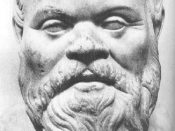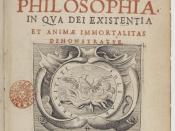Dirk Diggler Descartes Paper The purpose of the paper is to address the apparent circular argument Descartes has in Meditation 3, and how Meditation 5 solves it. I will attempt to draw information out of both Meditations that was not discussed in class. I will first briefly interpret both arguments for the existence of God, and then take up the circular argument.
Meditation 3 begins by introducing a general rule or truth rule that everything Descartes perceives clearly and distinctly is true. The reason for this truth rule is to move beyond the "ÃÂI think, therefore I exist', and to see if he can prove the existence of external objects and the validity of mathematics. He analyzes the fact that sensory judgments of certain things in the external world at first seem very real, but later prove to be questionable. Mathematics on the other hand passes through most of his scrutinizing except for the possibility that God may be deceiving him.
To make the truth rule of clarity and distinctness a valid one, Descartes must prove the existence of God and show that he is not a deceiver.
Descartes begins by defining the various types of thoughts we have. He separates them into three categories; ideas, thoughts, volitions or judgments. Descartes argues that only judgments have a truth significance. He then says that most deception comes from bad judgments about ideas. He further states that ideas by themselves are not true or false, but when we make judgments about these ideas they become true and false. Then he asserts there are three kinds of ideas; fictitious, adventitious, and innate. He contemplates the issue of adventitious ideas really coming from external objects, giving the example of heat from the fire and how he feels this heat whether he wants to...


